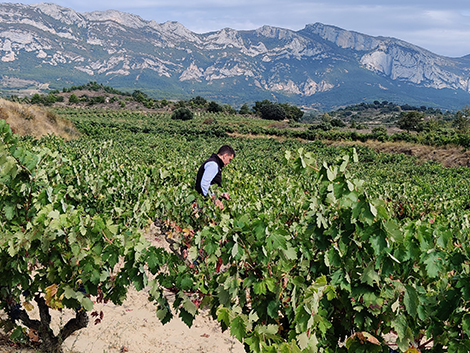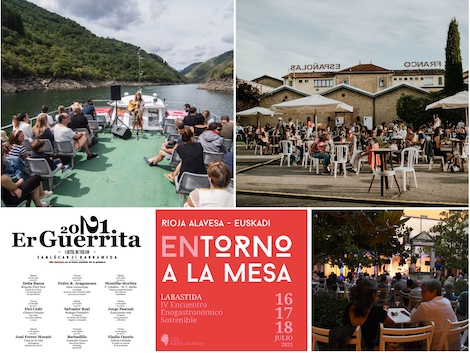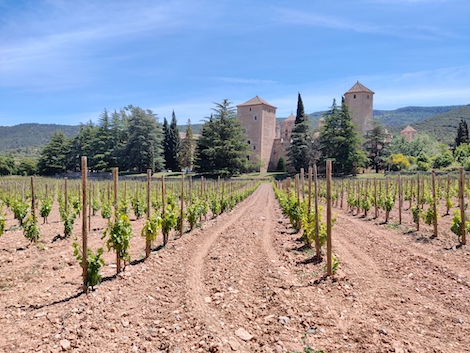
Generational change in wineries founded or relaunched in the 1990 to become leading players in the Spanish wine scene is likely to be critical for their future. At the helm of Alma Carraovejas, the wine division of the family group, Pedro Ruiz Aragoneses knows this well. He is not just driving the transformation of one of the most successful Ribera del Duero producers in Spain, but has also embarked on an expansion to “provide continuity to unique wine legacies” with the purchase of Viña Mein and Emilio Rojo in Ribeiro (Galicia), two wineries with no clear successors.
As well as the new estates in Galicia, Alma Carraovejas owns Ossian Vides y Vinos in Segovia, Milsetentayseis, a second winery in Fuentenebro, a distinctively elevated area in Ribera del Duero, the new Aiurri project in Rioja Alavesa, whose first grapes were harvested last year, and Ambivium, a Michelin-starred restaurant within the Pago de Carraovejas property.
The fourth of five siblings, Pedro studied Psychology and practiced his profession for three years. In 2007, when he took over Carraovejas at the age of 25, he tried to combine both activities, but wine finally took up all his time. Nevertheless, training as a psychologist has been key in terms of team management, one of his major strengths, and to professionalize a company that had just 15 employees when he joined.
Leaving behind ageing categories
Pedro is very different from his father. José María Ruiz is a true institution in Segovia (Castilla y León) since he opened the eponymous restaurant in the city’s historic quarter in 1982. On that year too his son Pedro was born and the DO Ribera del Duero was established. José María knew by then that wine would play an increasingly important role, so in the late 1980s he seized the opportunity to buy a property across the iconic castle of Peñafiel in the province of Valladolid. Pago de Carraovejas produced its first vintage in 1991.
His son has revolutionized the company’s culture and believes that employee training is essential. His youth has probably led him to surround himself with good professionals and advisors. Occasionally or on a more continuous basis, the list includes Vicente Gómez (soils), José Ramón Lisarrague (viticulture), Xavier Ausàs (winemaking), Simonit & Sirch (pruning), Rafael García of Vitis Navarra (plant material) and many others.
The most important change that he has introduced in the winery founded by his father was probably the merge of the Crianza and the Reserva into a single wine. It no longer bears an ageing category and retails between €30 and €35, a price segment increasingly popular among quality producers in Ribera del Duero. All this happened in the 2015 vintage. “Once Carraovejas reached its maximum production capacity, around 800,000 bottles, we focused on trading up the brand,” Pedro explained at that time.
The next obvious step, powered by the financial backbone provided by Carraovejas, was the expansion to other wine producing areas. Since the Ruiz family took full control of Ossian in Segovia, the winery focused on white wines, in 2016, the pace has quickened significantly. Perhaps 2017 might be a vintage to forget in most of Spain given the devastating frosts and the extremely early harvest, but Carraovejas can count its milestones: Milsetentayseis was born, Ambivium restaurant opened and obtained its first Michelin star. The purchase of Viña Meín and Emilio Rojo took place two years later, and the following vintage their first grapes in Rioja were being harvested.
From Segovia to Rioja via Galicia
This meteoric rise runs parallel to the mind expanding process that Ruiz Aragoneses has experimented in recent years. After acknowledging that, for him, “the world of wine didn’t use to go beyond Madrid and Burgos”, he is now convinced that “having projects in different areas has delocalised the business.”
Since I first met Pedro in 2016 during a visit to Pago de Carraovejas, we have seen each other on several occasions as I was researching different topics for my articles. I visited Fuentenebro at a very early stage of Milsetentayseis to learn more about quality aspects in elevated vineyards in Ribera del Duero. At that time, I could only taste barrel or foudre samples and try the first, fresh, vibrant vintage of a very limited production rosé which I would eventually learn that blended Tempranillo with other varieties (mainly Bobal) that can still found in very old vineyards in the area. The red was presented a couple of months ago in Madrid alongside samples from specific plots that are vinified separately, one of which was particularly promising. Overseeing the wines is Patricia Benítez, who worked closely with Peter Sisseck at Dominio de Pingus and was in charge of its laboratory. Pedro wanted to have an altogether new team: “We didn’t want to produce a second Carraovejas in Ribera,” he says.
The pandemic has not stopped the Ruiz Aragoneses family. After years of witnessing Riojan groups setting up in Ribera del Duero, the tables turned last summer. The arrival of Alma Carraovejas to Leza, a small village in Rioja Alavesa, caused a stir. While still in the midst of refurbishing the winery they had just acquired, we saw the first truckload of grapes being unloaded. The winemaking management here is also in the hands of Patricia Benítez.
A few weeks ago, they presented their Ribeiro wines. While Emilio Rojo single-vineyard white tops the range, there is a new entry-level wine, Pequeño Meín (little Meín) meant to upgrade its elder brother, now renamed Gran Meín (big Meín), as the previous owner’s single-vineyard wines have been blended back. There is also an interesting Gran Meín Tinto, particularly in the 2020 vintage. The presentation was attended by Emilio Rojo himself and winemaker Laura Montero, who is currently in charge of the wines.
There was yet another visit to Ossian in Nieva (Segovia), with a rich heritage of pre-phylloxera (Alma Carraovejas owns 55 hectares) and ungrafted vineyards. They are now in the midst of developing new plantings from their own vegetal material. Under the technical direction of Almudena Calvo, winemaker at Carraovejas, they are trying to return to less restrained winemaking. The vine heritage of this region is truly impressive.
A place to enjoy wine
Ambivium, finally, is the setting where all these projects are showcased, alongside great wines from all over the world and all sorts of beverages. A restaurant in which everything is built around wine is highly unusual. Visitors can choose to drink just one or several bottles or experience a long menu paired with 36 different wines and beverages, which is truly extraordinary, but also overwhelming and, in my opinion, even hard to handle. Isn't it unfair to devote so little time to some outstanding wines that deserve more attention?
There is a great deal of extravagance in this offering as it naturally invites diners to take a photo of a table overflowing with glasses at the end of the meal or a video exhibiting all the bottles (they don't fit in a single photo) that made a presence in your glasses at some point. For me it was interesting to taste an un-oaked Pago Carraovejas red from vineyards grown on the moor: it was refreshing and light, in great contrast with the usual style of their wines. I very much enjoyed some vintages that are no longer available like a 2016 Emilio Rojo magnum alongside Ossian and Capitel 2002 and Anejón and Cuesta de las Liebres from the late 2000s.
At present, Pedro Ruiz Aragoneses seems unstoppable. He is already thinking about a second Ambivium in Ribeiro focused on Galician cuisine, although we may probably hear earlier about a new foundation called Cultura Líquida (liquid culture) that is preparing the full translation into Spanish of Vignobles et vins du Nord-ouest de l'Espagne, one of the best documented works on Spanish wine written in the 1960s by French geographer Alain Huetz de Lemps. The translation of Simonit's books is also in the pipeline, as well as other publications about the wine regions where the group is based.
In addition to this, the group owns a small import and distribution company called SV Wines, that lists in Spain the champagnes of Charles Heidsieck and Italian producers like Biondi Santi and Marisa Cuomo. An international residence for cultural exchange is set to replace the old idea of building a hotel in Espantalobos, the colder hillside facing Pago de Carraovejas across the valley where, by the way, vineyards are also being planted to combat climate change.
Perhaps it is the commitment to wine culture that ultimately gives a different tone to the expansion of Alma Carraovejas. In terms of the group’s wineries, the strategy is not too different from other medium-sized and large companies in Spain in recent years. The novelty now is that they are taking up positions beyond the classic four "R's" of Spanish wine (Rioja, Ribera del Duero, Rueda and Rías Baixas), as they look into areas that could bring major quality developments in the future, such as Valdeorras, Bierzo or, in the case of Alma Carraovejas, Ribeiro. Depending on the work done in the coming years, the path could be infinitely more comfortable for the next generation.

Amaya Cervera
A wine journalist with almost 30 years' experience, she is the founder of the award-winning Spanish Wine Lover website. In 2023, she won the National Gastronomy Award for Gastronomic Communication
NEWSLETTER
Join our community of Spanish wine lovers






